Input interpretation

methyleugenol
Chemical names and formulas

formula | H_2C=CHCH_2C_6H_3(OCH_3)_2 Hill formula | C_11H_14O_2 name | methyleugenol IUPAC name | 4-allyl-1, 2-dimethoxybenzene alternate names | 1, 2-dimethoxy-4-(2-propenyl)benzene | 1, 2-dimethoxy-4-prop-2-enyl-benzene | 1, 2-dimethoxy-4-prop-2-enylbenzene | 1-(3, 4-dimethoxyphenyl)-2-propene | 1, 3, 4-eugenol methyl ether | 1-allyl-3, 4-dimethoxybenzene | 4-allyl-1, 2-dimethoxy-benzene | 4-allyl-1, 2-dimethoxybenzene | 4-allylveratrole | benzene, 1, 2-dimethoxy-4-(2-propenyl)- | eugenol methyl ether | eugenyl methyl ether | veratrole methyl ether mass fractions | C (carbon) 74.1% | H (hydrogen) 7.92% | O (oxygen) 18%
Lewis structure
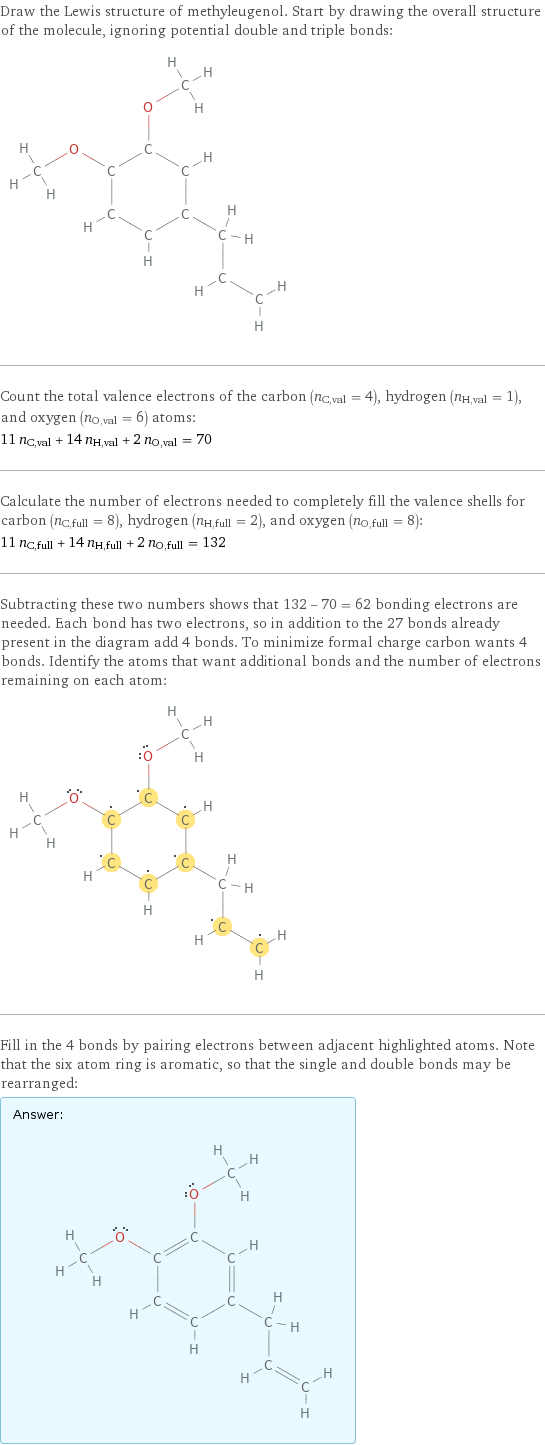
Draw the Lewis structure of methyleugenol. Start by drawing the overall structure of the molecule, ignoring potential double and triple bonds: Count the total valence electrons of the carbon (n_C, val = 4), hydrogen (n_H, val = 1), and oxygen (n_O, val = 6) atoms: 11 n_C, val + 14 n_H, val + 2 n_O, val = 70 Calculate the number of electrons needed to completely fill the valence shells for carbon (n_C, full = 8), hydrogen (n_H, full = 2), and oxygen (n_O, full = 8): 11 n_C, full + 14 n_H, full + 2 n_O, full = 132 Subtracting these two numbers shows that 132 - 70 = 62 bonding electrons are needed. Each bond has two electrons, so in addition to the 27 bonds already present in the diagram add 4 bonds. To minimize formal charge carbon wants 4 bonds. Identify the atoms that want additional bonds and the number of electrons remaining on each atom: Fill in the 4 bonds by pairing electrons between adjacent highlighted atoms. Note that the six atom ring is aromatic, so that the single and double bonds may be rearranged: Answer: | |
3D structure

3D structure
Basic properties
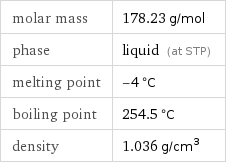
molar mass | 178.23 g/mol phase | liquid (at STP) melting point | -4 °C boiling point | 254.5 °C density | 1.036 g/cm^3
Units

Liquid properties (at STP)
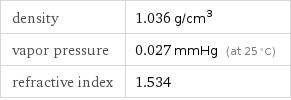
density | 1.036 g/cm^3 vapor pressure | 0.027 mmHg (at 25 °C) refractive index | 1.534
Units

Thermodynamic properties
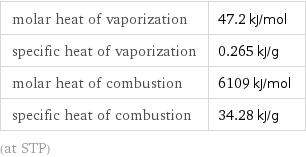
molar heat of vaporization | 47.2 kJ/mol specific heat of vaporization | 0.265 kJ/g molar heat of combustion | 6109 kJ/mol specific heat of combustion | 34.28 kJ/g (at STP)
Chemical identifiers
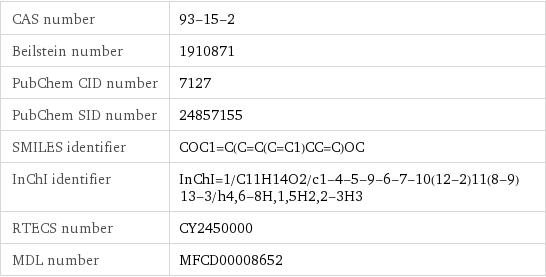
CAS number | 93-15-2 Beilstein number | 1910871 PubChem CID number | 7127 PubChem SID number | 24857155 SMILES identifier | COC1=C(C=C(C=C1)CC=C)OC InChI identifier | InChI=1/C11H14O2/c1-4-5-9-6-7-10(12-2)11(8-9)13-3/h4, 6-8H, 1, 5H2, 2-3H3 RTECS number | CY2450000 MDL number | MFCD00008652
NFPA label

NFPA label
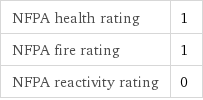
NFPA health rating | 1 NFPA fire rating | 1 NFPA reactivity rating | 0
Safety properties

flash point | 110 °C

DOT numbers | 2810
Toxicity properties

RTECS classes | agricultural chemical and pesticide | tumorigen | mutagen | primary irritant